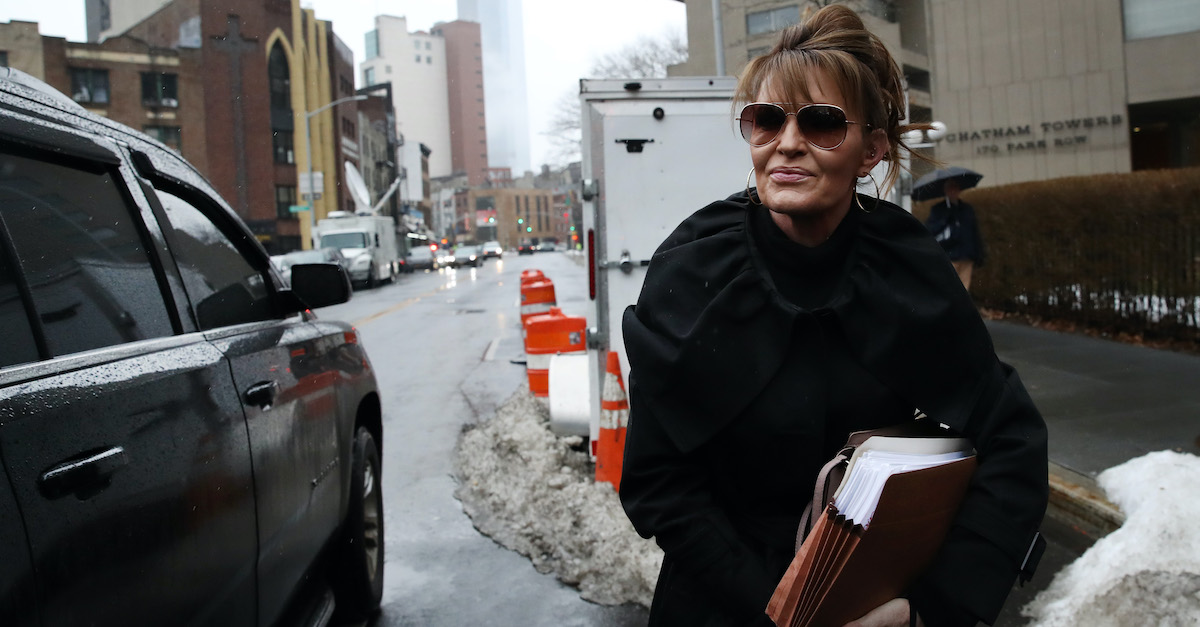
NEW YORK, NEW YORK – FEBRUARY 03: Former Alaska Gov. Sarah Palin arrives at a federal court in Manhattan to resume a case against the New York Times after it was postponed because she tested positive for Covid-19 on Feb. 3, 2022 in New York City.
With surprising timing, a federal judge indicated on Monday that he’ll throw out former Alaska Gov. Sarah Palin’s lawsuit against The New York Times, finding that no reasonable jury could find that the paper and its editor James Bennet acted with actual malice.
“I think that there is one essential element that plaintiff has not carried its burden with—the portion of actual malice relating to belief in falsity or reckless disregard in falsity,” Senior U.S. District Judge Jed Rakoff remarked from the bench.
The jury was still deliberating when Rakoff issued his ruling.
“My job is to decide the law,” he said. “The law sets a very high standard, the court finds that that standard has not been met.”
A one-time vice presidential candidate on John McCain’s ticket, the folksy Palin once sold merchandise with the motto: “Suck it up, cupcake.”
An attorney for the New York Times threw those words back at her during closing arguments on Friday. Despite calling the Times editorial “very unfortunate,” Judge Rakoff apparently agreed that Palin shouldn’t have made a federal case of an error in a four-year-old editorial that was corrected 12 hours later.
Palin claimed that the 2017 editorial “America’s Lethal Politics” defamed her by linking her to a deadly mass shooting some six years earlier.
Before it was corrected, the editorial asserted that the “link to political incitement was clear” when Jared Lee Loughner opened fire more than a decade ago in Tucson, Arizona, killing six people and injuring 13, including Rep. Gabrielle Giffords. The editorial board had been referring to a map disseminated by Palin’s political action committee Sarah PAC, which had stylized crosshairs over the electoral districts of Giffords and 19 other Democrats. No link was ever established between the shooting and the maps.
The Times does not dispute that they made an error, but their attorney David Axelrod argued that their speedy correction showed the paper’s then-editors harbored no actual malice, a standard that has been law of the land in defamation cases since the watershed precedent in New York Times vs. Sullivan more than half a century ago.
“Freedom of the press and freedom of speech are fragile things,” Axelrod told a jury shortly before their deliberations on Friday afternoon.
Shortly before ending his summations, Axelrod added: “the First Amendment is so important that honest mistakes don’t create liability.”
Written in reaction to the 2017 congressional baseball practice shooting by James Hogkinson—who shot Rep. Steve Scalise (R-La.) and other Republicans—the editorial invoked the Loughner shooting some six years earlier as another example of a Congress member being victimized by gun violence. Axelrod argued that the Palin was something of a “footnote” to the original editorial, which criticized politicians across the aisle.
The editorial, which even praised Donald Trump, noted that Hodgkinson was a supporter Sen. Bernie Sanders (I-Vt.).
Palin’s attorney Kenneth Turkel claimed then-Times editor James Bennet “hated” his client because of his politics, but there was little evidence of that at trial. Bennet apologized to Palin during his testimony, and Judge Rakoff previously threw out Palin’s claim of punitive damages, finding evidence of Bennet’s ill will is “quite modest indeed.”
Bennet put the finishing touches on the unsigned editorial, and the initial draft, written by Elizabeth Williamson, did not included the disputed language. It was not Bennet’s decision to even refer to Palin in the original editorial, and internal Times communications showed that they scrambled to quickly correct the story amid criticism.
During her testimony, Palin acknowledged that she did not request a correction or apology at any point after it ran on June 14, 2017, one day after the congressional baseball practice shooting. She posted that she was “exploring options” on a lawsuit on Twitter the next day.
Judge Rakoff noted that his ruling “will inevitably go up on appeal.”
As a result, he will allow the jury to have its say.
“The Court of Appeals, I think, will greatly benefit from knowing how the jury will decide,” Rakoff said.
He said that the jury’s verdict will inform the Second Circuit of their view of the facts.
Attorney Mitchell Epner, who has consulted with media organizations on First Amendment and copyright issues and is now of counsel with Rottenberg Lipman Rich PC, called Rakoff’s timing “very unusual.”
“I would have expected the judge to wait for the jury to return its verdict before ruling on the motion for judgment as a matter of law, because there was no urgency to issuing that ruling,” Epner noted. “Nothing would have changed if he had waited for the verdict to have been announced, or for the jury to say that they couldn’t reach a verdict. This introduces another potential appellate issue, because if Sarah Palin loses in front of the jury, […] on appeal, one of the arguments that I would expect her attorneys to make is that the news of the ruling by the judge couldn’t help but it seeped its way into the knowledge of the jury.”
Their deliberations will continue on Tuesday, and Rakoff instructed them not to view media coverage.
When Palin original filed the case in 2017, Rakoff granted the Times motion to dismiss before being reversed on appeal for a procedural oddity. He granted an evidentiary hearing at a stage when he was supposed to accept the allegations of the complaint as true. The appellate court’s reversal gave Palin access to the newspaper’s internal communications. Rakoff later found the evidence enough for a jury to hear the case.
(Photo by Spencer Platt/Getty Images)